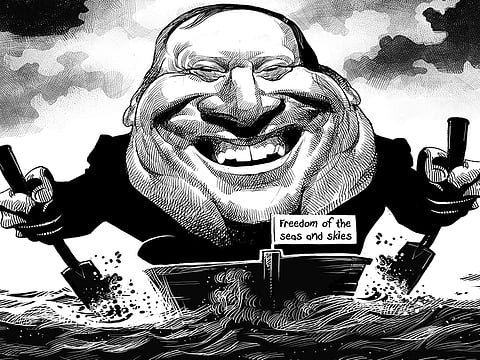Pompeo trip seeks traction for US-Asia strategy
US secretary of state faces a very tough task in reassuring America’s regional allies that the Trump team is wholly committed to its Indo-Pacific plan

Mike Pompeo finished up on Friday his trip to India after signing on Thursday the Communications Compatibility and Security Agreement (Comcasa) military cooperation deal. The success brought a positive end to a tricky trip to Islamabad and New Delhi where the United States secretary of state sought traction for his revamped Indo-Pacific strategy in the face of China’s growing strength.
In India, Pompeo and US Defence Secretary James Mattis met their counterparts — External Affairs Minister Sushma Swaraj and Defence Minister Nirmala Sitharaman — for so-called “two-plus-two” talks to strengthen the bilateral partnership. Sitharaman hailed the Comcasa deal as elevating ties “to unprecedented heights”, while the US side depicted it as a breakthrough too.
Part of the rationale for the revamped US Indo-Pacific strategy (the Donald Trump team’s preferred phrase for the massive geography spreading from the US west coast to India), is that New Delhi could potentially act as a growing regional counterweight to Beijing. Mattis, for instance, has said that “we see the strengthening of India’s democracy, its military, its economy as a stabilising element in the world”.
The deepening of the US-India relationship is centred, according to Washington, around promoting a regional agenda of ensuring “freedom of the seas and skies, promoting market economics, supporting good governance, and insulating sovereign nations from coercion”. To this end, US policymakers had declared New Delhi a major US defence partner in 2016, and the new Comcasa will now underpin greater counter-terrorism and defence cooperation.
While the New Delhi leg of the US tour was relatively smooth sailing, the Islamabad stop off was much more difficult. Pompeo said after the meeting with new Pakistani Prime Minister Imran Khan that he hopes for a “re-set of relations”. While Imran has deployed much anti-US rhetoric over the years, the US secretary of state rightly sought early engagement with him, especially with Chinese Foreign Minister Wang Yi — who has called Pakistan the “iron brother” of his own nation — passing through Islamabad at the weekend after Pompeo.
For strategic political reasons, the new Pakistani prime minister is being courted by both Washington and Beijing with the latter having already made commitments of around $60 billion (Dh220.68 billion) to Islamabad under its Belt and Road Initiative (BRI). Pakistani troops also recently took part in exercises with some 3,000 others from the Shanghai Cooperation Organisation (SCO), including the Chinese military.
While Islamabad had for decades been a key US ally, the relationship has frayed significantly. This was highlighted last month when a transcript of a phone conversation between Pompeo and Imran, released by the US State Department, that referred to the new government “taking decisive action against all terrorists operating in Pakistan”, was disputed as factually inaccurate by Imran’s team.
It was this vexed terrorism issue that was the key item on the agenda on Wednesday between Imran, Pompeo and Mattis. And this conversation was made no easier by the US military decision last week to cancel $300 million in aid to Islamabad over what Washington calls its failure to take action against militant groups operating on its soil.
Mattis asserted that tough talks were needed on Wednesday and that he and Pompeo made “very clear what we have to do, all of our nations, in meeting our common foe — the terrorists”. It is likely that the US team put pressure on Imran to act more robustly and offered greater support and/or incentives for doing so, following US Joint Chiefs-of-Staff Committee General Joseph F. Dunford’s assertion recently that US interests in the region requires “a presence to have influence”. What that presence exactly means, in practice, is unclear, and this was potentially a tense topic of conversation.
Pompeo’s South Asia tour, on the back of his visit last month to Indonesia, Singapore and Malaysia, was designed to see clear movement forward on US agendas in both India and Pakistan to help bring greater energy and credibility to the US Indo-Pacific strategy, which has come under criticism for its perceived (under) ambition vis-a-vis China. That is why the US secretary of state last month articulated his revamped plans for a “new era in US economic commitment to peace and prosperity in the region”.
Pompeo announced some $113 million in regional investments focused on technology, energy and infrastructure. In the secretary of state’s words, this is “just a down payment” on future US commitments to the region.
Welcome as more details of the administration’s emerging plan are for many US allies — especially coming after US President Donald Trump’s decision not to attend November’s Apec and Asean summits — critics claim that it will have less overall impact than the Barack Obama administration’s Trans-Pacific Partnership (TPP) strategy. And the added pressure on the White House is China’s monumental ambition in comparison as illustrated by the $1 trillion BRI.
In this context, Pompeo faces a very tough ask in reassuring sometimes sceptical US regional allies that the Trump team is wholly committed — politically, economically and security-wise — to its Indo-Pacific plan. Even with Thursday’s success with Comcasa in India, questions will remain about the ambition of the US strategy, especially given the scale of China’s own plans.
Andrew Hammond is an associate at LSE IDEAS at the London School of Economics.
Sign up for the Daily Briefing
Get the latest news and updates straight to your inbox



